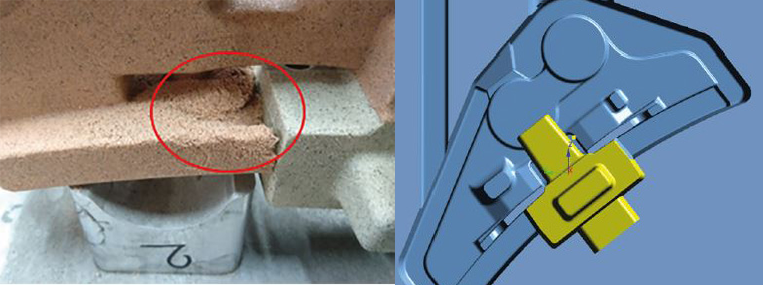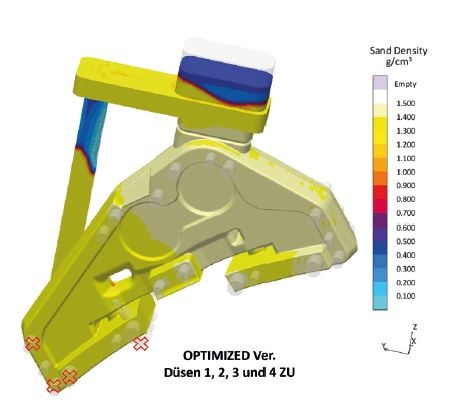No Fear of Challenges
Unusual requests require innovative ideas. It is time to get out of the comfort zone and enter new creative territory. This is the only way to find a solution for almost any problem.
LIVAR in Slovenia had to deal with a somewhat unusual project. The foundry received a request for manufacturing a ductile iron casting. In order to be able to represent the special geometry, the foundry decided to first produce a core segment and then overshoot it in a second core box.
In the first cores produced, the surface of the inserted sand core was not completely filled with sand. Manually adding extra vents and flow paths did not improve the situation.
As a MAGMASOFT® user, LIVAR was familiar with the possibilities of the core shooting simulation and turned to its contact in Slovenia, the company EXOTERM-IT. MAGMA C+M was implemented to investigate and solve the problem.
The first simulation was performed with standard data. However, in the critical area, the results still showed too high sand densities. Therefore, it was decided to first calibrate the sand properties and shooting parameters. For this purpose, a virtual design of experiments was defined in MAGMA C+M, and a total of 36 designs with different sand properties were tested. The results were compared in the critical zone with an evaluation area. Using the main effects diagram, which shows the influence of different sand and process conditions on the core density, optimized sand data for LIVAR could be determined.
After calibrating the sand properties, it was possible to identify and systematically investigate the causes of the core defect occurred. With the help of the simulation results, LIVAR was able to show that the air pressure differences near the critical area were too small to transport the sand to the inserted core segment. Therefore, the sand initially flowed through narrow passages above the critical area and compacted, thus stopping the further transport of the sand.
In order for the sand to reliably fill the critical areas, the pressure gradient should therefore be increased by closing shoot nozzles. For this purpose, another virtual design of experiments was carried out: Shoot nozzles were automatically switched off in pairs on each half of the core box, starting with the vents farthest from the critical area.
In the Assessment Perspective of MAGMA C+M, two objectives were analyzed: the average and the minimum sand density in the critical area of the core. From the six variants, version 4 showed the best results. By systematically switching off four shoot nozzles, the pressure differences were significantly increased. This allowed the sand to be transported to the end of the critical area.
The verification of this solution in the real core box immediately resulted in good core quality. The bottom line: The virtual optimization was successful, and, despite initial difficulties, LIVAR was able to reliably meet the customer's requirements.
About LIVAR d.d.
As one of the largest foundries in Slovenia, LIVAR employs over 750 people. The foundry produces high-quality gray and ductile iron castings. LIVAR has its own tooling and machining shop. The technology department is equipped with the latest tools, including MAGMASOFT®. The casting process is constantly monitored using various control systems, ensuring comprehensive quality control.







